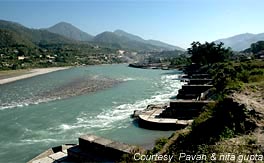Geothermal systems in the Northwest Himalaya
Conventional energy resources are fast depleting and therefore alternative resources are required to sustain the fast progress and development of any nation. This situation is more pertinent to India
Conventional energy resources are fast depleting and therefore alternative resources are required to sustain the fast progress and development of any nation. This situation is more pertinent to India
The extraction of medicinal and aromatic plants in India leads to lot of wastage which is needed to curtail with the use of latest foreign technology and the matter will be discussed with the Uttarakhand
A detailed analytical study of major cations (Ca2+, Mg2+, Na+, K+) and anions (SO2− 4 , HCO−3 , Cl−, NO−3 ) of meltwater draining from Gangotri Glacier was carried out to understand major ion chemistry
The complex interaction of environmental stress, poor natural regeneration and insect pests have lead to forest decline in Himalayan sub-region. Amongst the insects, stem and wood boring beetles are capable
<p> Rain claimed four lives in Uttar Pradesh and forced officials to issue an alert in Uttarakhand as the monsoon remained fairly active in North India on Wednesday.</p>

<p><span id="itro1">MoEF has issued this order on Shrinagar hydro power project being constructed by Alaknanda Hydro Power Company Limited to prevent pollution of Alaknanda river and the surrounding environment.</span></p>
In an extensive survey to Garhwal Himalaya and arid soil of western Rajasthan, twenty four leguminous nitrogen fixing species were identified including seven herbs, nine shrubs, four climbers and four
<p>During the last two decades much has been written about the biodiversity richness of country. Avoiding all the numerical details about the documented species an attempt has been made to provide information about the relative forest systems of India. For classifying the vegetation the altitude has been adopted as vital factor in detailing the vegetation.</p>
Lichenometric studies in the vicinity of the Pindari Glacier have been recently reported. (Correspondence)
SITTING ON the mud porch of his house in Uttarakhand, 80-yearold Maulya Singh looks stoically at the burnt stumps of pine a few metres away and talks philosophically of the land drying up. His daughter-in-law is, however, more concerned about the practicalities. As most springs in the village are dry, she is forced to trudge farther and farther afield to get drinking water.
This paper reports regeneration status of trees in two watersheds namely Phakot and Pathri Rao in Uttarakhand. Seedling, sapling and tree density were greater in Phakot watershed forest than those in Pathri Rao watershed forest. In general, both forests were regenerating, although seedling and sapling population was higher in Phakot watershed forest.